We grow a record crop of tomatoes in a polycarbonate greenhouse: planting and care, advice from agronomists
Greenhouses with polycarbonate cover are confidently replacing their film and even glass predecessors. Their growing popularity is explained not only by the ease of installation and relative cheapness, but also by the properties of polycarbonate.
A special microclimate for plants is created inside such a greenhouse. Since you can start planting crops much earlier than the beginning of the season, and finish much later, the fruiting period is extended, the yield increases. In this article, we will consider how to grow a rich crop of tomatoes in a greenhouse.
The content of the article
- The best varieties for the greenhouse
- How to grow strong tomato seedlings?
- How to prepare a greenhouse for planting tomatoes
- Planting seedlings and caring for tomatoes
- Transplanting plants into a greenhouse
- Seedling care in the greenhouse
- Some Tips for Proper Tomato Care
- What is the difference between the process of growing tomatoes in a greenhouse
- Conclusion
The best varieties for the greenhouse
To grow a good harvest, agronomists advise purchasing F1 varieties or hybrids that are disease resistant.The best option for polycarbonate greenhouses is indeterminate varieties, which are characterized by unlimited growth.
For growing in polycarbonate greenhouses, hybrids are well suited: Alexia F1, Ivanhoe F1, Michelle F1, Empire Raspberry F1, Catherine the Great F1, Eupator F1, etc. Caring for them is simple, but it requires the formation of a bush in one trunk, constant pinching, feeding during the season. Some of the varieties can be grown in heated greenhouses during the winter.
In polycarbonate greenhouses, varietal tomatoes are successfully grown, such as Honey Drop, Thick Cheeks, Moskovskaya Cream, Di Barao group of varieties, Bull heart, Heart of Gold and others.
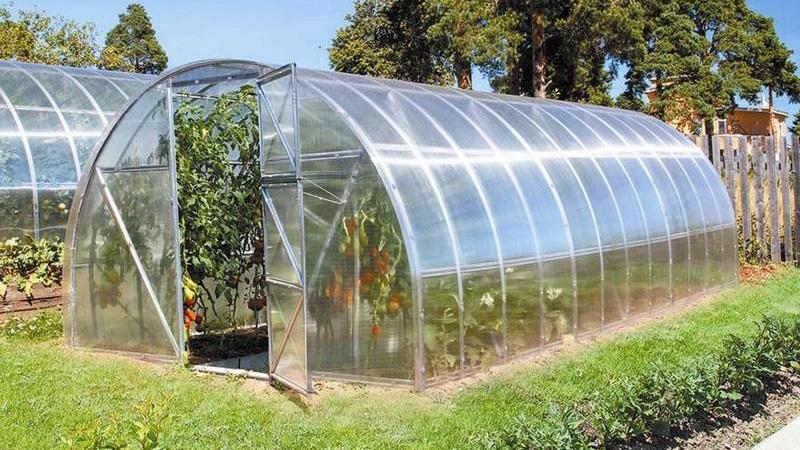
How to choose tomato varieties for a polycarbonate greenhouse?
The choice of a variety for growing in a greenhouse depends on the purpose of growing (for juice, lettuce, canning, for drying), as well as on specific conditions (climate, area and heating capacity of the greenhouse, etc.).
Keep in mind that early or mid-season varieties or hybrids are suitable for cold regions, which, when sown on seedlings in early March in a polycarbonate greenhouse, have time to ripen.
How to grow strong tomato seedlings?
The key to a rich harvest is healthy and strong seedlings. Correctly grown seedlings quickly take root in the ground, form a strong green plant, begin to bloom and bear fruit within the time frame set for this variety.
To grow it correctly, you need to know some of the subtleties of preparing the soil and seeds for planting, as well as the peculiarities of caring for seedlings.
When to plant tomatoes for greenhouse seedlings
With a greenhouse, summer is extended by about four weeks, and if you have a heated greenhouse with backlighting, then it will last all year round.
Not all gardeners can afford heated polycarbonate greenhouses, so most plant tomatoes in unheated greenhouses. For this reason, we give the timing of planting tomatoes for seedlings for unheated greenhouses.
Residents of the middle lane are recommended to plant tomatoes for seedlings in the first half of March.For gardeners of the northern regions, it is better to start planting in early April. Seedlings at the time of planting in the greenhouse should be 30-40 cm high, with 9-10 leaves.
How to prepare a greenhouse for planting tomatoes
They begin to prepare the greenhouse for spring planting in the fall. Plant residues, weeds, supports and garters are removed from the greenhouse. The foliage affected by diseases and pests is burned. Healthy plants and weeds can be piled up in a compost heap, layered with organic fertilizers or spilled with urea solution.
The greenhouse should be cleaned with a sponge and soapy water or detergent solution. Another option is to use the sponge mop on the handle to make the job easier. First, a soap solution is applied, let it “work” for 5-10 minutes and rinse with clean water from a hose.
Attention! It is forbidden to use aldehydes, chlorine and solvents, abrasive substances as a washing solution, since the top layer of polycarbonate does not tolerate aggressive effects. When applied, scratches and stains may remain on the surface.
The next important step is the processing and disinfection of the greenhouse. First, decide on the scope of work. If during the summer there were practically no pests and diseases in the greenhouse, it is enough to carry out the treatment with sparing biological products ("Fitosporin", "Glyokladin", "Trichocin", "Baikal-EM1"; "Shining"; "Phoenix"; "Fitop-Flora-S " etc.).
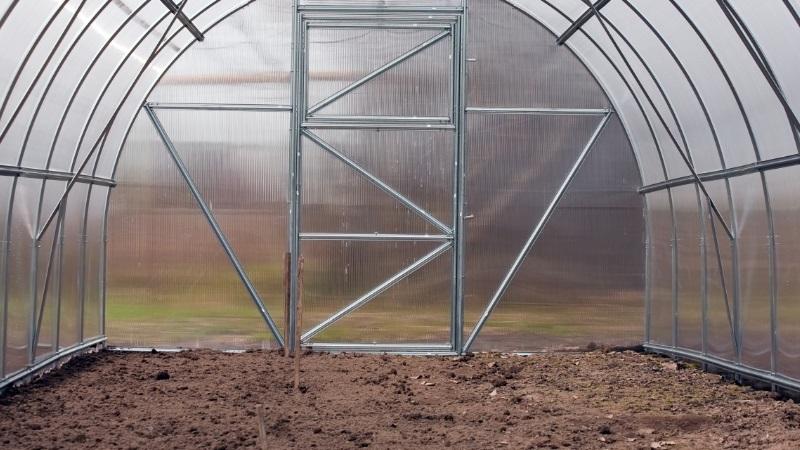
Advice... Since spores of fungi and bacteria are located mainly on the surface of the soil, it should not be dug up before treatment with antibacterial compounds and fungicides.
Simultaneously with the introduction of biological products, complex fertilizers are introduced into the soil: superphosphate, nitroammophoska or organic matter.
Use chemistry if plant diseases or a large number of pests have been noted in your greenhouse or neighbors over the summer. An excellent result is given by copper sulfate, pharmayod, bleach, bordeaux liquid, formalin, and freezing.
A radical method of dealing with pests and bacteria is the sulfur checker. It is effectively used to combat whitefly. The smoke emitted by a sulfur checker contains sulfur dioxide, which kills parasites, pests and microorganisms.
Attention! A plaque may appear on the walls of the greenhouse and the frame, which is better to gently wash off with a sponge, being careful not to get it on the soil. On contact with water, it turns into acid and acidifies the soil.
A much simpler and "clean" radical method of combating whitefly and other types of insects hibernating in the soil with pests and diseases is freezing the greenhouse. For this, the vents or doors are slightly opened.
In addition, the open window helps to equalize the temperature inside the greenhouse, as a result of which condensation and ice will not form on its walls, and it will be much easier to remove snow from polycarbonate.
In winter, the main concern of a good gardener is to prevent snow and ice from accumulating on the roof of the greenhouse. They can damage the polycarbonate. To reduce the problems with snow removal, we recommend choosing greenhouses with a steep roof slope or a streamlined shape.
If the roof of the building is flat or arched, then it must be regularly cleaned of snow masses.
Planting seedlings and caring for tomatoes
In order for tomato seedlings at home to be healthy and strong, you must:
- select and / or prepare the soil correctly;
- pick up varieties;
- prepare seeds;
- sow on time;
- maintain water balance;
- to carry out feeding;
- to swoop down correctly.
Soil preparation
The stores offer a large selection of potting mixes for growing seedlings. We advise you to choose such proven brands as "Zhivaya Zemlya", "Microparnik", Biud Grunt "," Gumimax "," Sadovaya Zemlya ".
If you don't trust the soil from the store, prepare it yourself from equal parts of peat and sand with the addition of sawdust or mullein.
Before planting plants, be sure to disinfect the soil - it does not matter if it is store-bought or prepared by yourself. To do this, the earth is placed in special containers and placed in a microwave or oven for 20-30 minutes. Then the soil mixture is spilled with a phytosporin solution, while the soil temperature should not be higher than 25-30 ° C.
Seed preparation
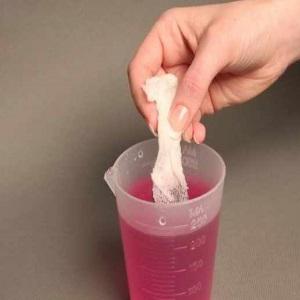 Before sowing, the seeds must be sorted out, leaving large and full ones. Selected seeds for the prevention of viral diseases are kept in a weak solution of "Imunocytofit" (1 tablet per 100 ml of water) for 3-12 hours.
Before sowing, the seeds must be sorted out, leaving large and full ones. Selected seeds for the prevention of viral diseases are kept in a weak solution of "Imunocytofit" (1 tablet per 100 ml of water) for 3-12 hours.
An alternative is to keep in the Fitosporin solution.
A solution of potassium permanganate (potassium permanganate) works well. The seeds are soaked in 1% potassium permanganate solution for 45 minutes. After that, the planting material is rinsed with water and dried.
The timing of planting seeds for seedlings
Don't rush to sow early, in January or February. Seedlings with such sowing are "tortured", take root worse and yield a harvest later. In the conditions of Central Russia, it is better to sow seeds for seedlings in March.
Sowing seeds
The prepared seeds are sown in small boxes or containers about 15-20 cm high, with a distance of 5-10 cm between the seeds. The depth of planting seeds is 1 cm. If you do not want to dive the seedlings, it is better to plant the seeds not in boxes, but each in a separate cup or peat pot.
Seeds are planted in moist soil, warmed to room temperature. Before the first shoots appear, containers with seeds should be under film or glass.
After the emergence of seedlings, the film or glass is removed, and the container is transferred to a lighted windowsill. It is enough to water young seedlings twice a week using a fine spray.
Seedling picking
 After the appearance of 2-3 true leaves (approximately 2-3 weeks after sowing), the seedlings dive.
After the appearance of 2-3 true leaves (approximately 2-3 weeks after sowing), the seedlings dive.
A pick for seedlings is a serious stress. Therefore, after this procedure, the seedlings need special care, which consists in the fact that they should not be in direct sunlight, it should not be hot in the room - it is desirable that the temperature be around + 18 ° C.
Water the seedlings during the rooting period (3-5 days) especially carefully. Plants respond well to feeding with such preparations as "Zircon", "Athlete".
Transplanting plants into a greenhouse
Proper planting and care is the key to a good harvest. One of the main conditions for success is a good choice of planting dates if the greenhouse is unheated. Sudden temperature changes are stressful for young plants.
In the middle lane, tomatoes begin to be planted when the ground warms up to a depth of 20 cm, i.e. from the end to the middle of the first decade of May. It is recommended to transplant into a greenhouse when the length of the plant stem reaches 30-40 cm, and the number of true leaves is 9-10 pcs.
In northern regions, choose tomato varieties with a shorter life cycle than for the middle lane.
Landing patterns
A well-chosen planting scheme should provide the plants with good illumination. The distance between seedlings depends on the height of the plants and the growing conditions.
So, when growing tall tomatoes, the distance between rows can be up to 1 m, between bushes - 70 cm. In some cases, the interval can be reduced: 70-90 cm between rows and 50-60 cm between bushes.
The distances between bushes of medium-sized tomatoes can be reduced to 55 cm, and between rows to 70-80 cm. It is permissible to slightly change these parameters, taking into account the variety.
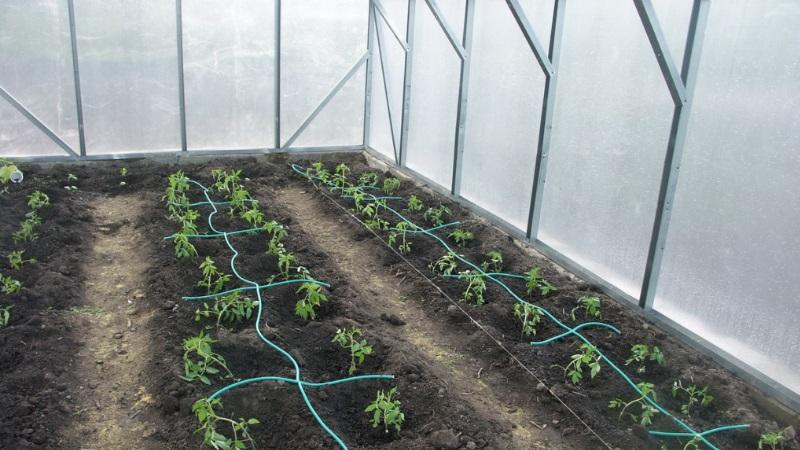
Plants arrangement
It is best to "stretch" the beds along the long walls of the greenhouse and arrange them in the form of two or three separate strips or in the form of letters "P" or "W", with their legs turned towards the entrance.
The width of the beds is calculated individually, its optimal value is 60-90 cm. The main thing to remember is that the minimum distance between the bushes during planting cannot be less than 50 cm, and 10 cm or a little more must be retreated from the border of the garden.
reference... Greenhouse beds are usually made 20-40 cm above the ground level, because the ground raised above the ground warms up better and faster.
Seedling care in the greenhouse
The first 10-15 days after planting in the greenhouse, the seedlings will take root. For this process to be successful, it is necessary to maintain the temperature in the range of 20-22 ° C and shade young plants from direct sunlight.
Watering the seedlings begins after 10 days, since at the time of transplantation the plants are well watered. To get a decent harvest of tomatoes in a greenhouse, quality care of the crop is needed throughout the summer: pinch, water and fertilize in a timely manner.
How to care for tomatoes in a greenhouse
Seedlings planted in a permanent place needs proper care, without which it will be difficult for her to take root and gain strength. Caring for plants after planting in a greenhouse will not cause difficulties if you follow the basic rules:
- The first watering is carried out after planting tomatoes in the ground... It should be abundant and soak the soil 15-20 cm to ensure good root-to-soil contact.
- Airing... It is necessary to open the doors and all available vents after watering so that condensation does not form on the polycarbonate walls and the roof, and the humidity does not rise to unacceptable limits.
- Watering should not be started before the seedlings grow. Pulling out the stem and branches is a signal that the plant has taken root, and it needs food, including water. Previously, watering is not recommended, since excessive moisture can lead to root rot and the death of the seedling.
Water consumption for young plants is 5-7 liters per 1 m² of the garden. As the bushes develop, the rate increases: with the beginning of flowering up to 12 liters, and with the onset of hot weather and the beginning of fruiting - up to 15 liters.
Watering is recommended in the absence of direct sunlight - in the evening or early morning. The soil moisture level should not exceed 70%.
Garter and feeding
An obligatory event when growing tomatoes - garter... Tied-up bushes are better illuminated and ventilated than those spread out on the ground. In addition, tying the bushes to the support reduces the risk of spreading fungal diseases.
Tomatoes are fed 3-4 more times during the season. In the initial period of development for tomatoes, it is best to use mullein or fermented aqueous solution of cow dung. Also, ammonium nitrate and urea at the rate of 1 tbsp are used as the first feeding. spoon on a bucket of water.
Advice... Any top dressing for tomatoes is carried out only after watering.
Top dressing during flowering
During the budding and flowering period of the first two brushes, the watering rate of tomatoes is reduced to 1-2 liters for each bush, with an interval between watering of 5-7 days. Do this to curb the growth of green mass and stimulate the formation of ovaries.
In the flowering phase, it is necessary to fertilize tomatoes with fertilizers containing potassium and phosphorus. The main emphasis is on foliar feeding, since in this case the necessary elements are absorbed by the plants faster.
As fertilizers used superphosphate (2 tbsp. L per 10 l of water), potassium monophosphate (2 tbsp. L per 10 l of water), as well as complex fertilizers ("Solution", "Master-agro for tomatoes" and others).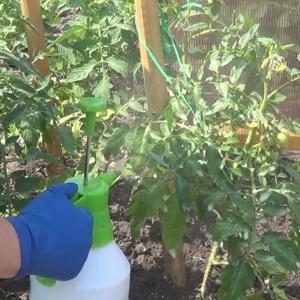
Quite good results are obtained by feeding with a milk solution with iodine (1 liter of milk, 15 drops of iodine, 10 liters of water), yeast feeding (10 g of yeast, 2 tablespoons of sugar, a bucket of water).
Foliar top dressing of tomatoes is carried out every 7-10 days. To stimulate the formation of an ovary during flowering, tomatoes are processed boric acid solution, for the preparation of which 5 g of the drug is dissolved in 10 liters of water, or sprayed with the drug "Ovary".
Among experienced gardeners there is an opinion that during the growing season of tomatoes it is necessary to carry out at least three foliar dressings in the following phases of plant development:
- in the phase of two true leaves of tomato seedlings;
- during flowering;
- during the period of mass fruiting in the second half of summer.
However, the use of foliar dressings on tomatoes is not limited in any way; they can be performed every 10 days during the entire growing season, alternating with root dressings.
Watering and feeding during fruit ripening
When the tomatoes begin to sing, watering is increased, preventing the soil under the plants from drying out. To keep moisture in the ground better, plantings are mulched with straw, compost, humus. In extreme heat, peat or sawdust is poured around the trunks.
Advice! When watering, adhere to the rule: if the soil is dry at a depth of 2-3 cm, then it is time to water the tomatoes, and if it is still wet, you can wait a little longer with watering.
On a hot sunny day, tomatoes are watered either early in the morning or two hours before sunset. After each watering, it is advisable to loosen the soil around the tomatoes, preventing the formation of a crust on the soil.
In the ripening phase of tomatoes, potash and phosphorus fertilizers are applied every two weeks.
Important... It is possible to feed tomatoes with ash solution only after preliminary watering, otherwise the roots will get burned.
During the ripening period, you should not fertilize the plants with nitrogen-containing fertilizers, including organic ones (mullein, chicken droppings, etc.).
Potential pests and diseases
To protect tomatoes from pests and diseases, it is necessary to carefully inspect them periodically and carry out preventive treatment.
The most common pests of tomatoes: spider mites, whitefly, gnawing scoop, rootworm nematode, wireworm, bear.
From insect pests spraying with Fitoverma solution helps well. In addition to them, pathogens of various diseases can also get into indoor ground.
Diseases of tomatoes in a greenhouse are divided into three groups:
- fungal diseases (powdery mildew, gray rot, late blight, cladosporosis, alternaria, anthracnose, fusarium, root rot, sclerotinosis, didimella fungus);
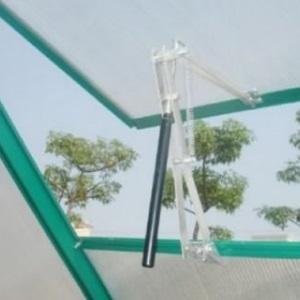
- viral diseases (aspermia, necrosis, mosaic);
- bacterial (black spot, tomato cancer).
The best way to deal with them is prevention. First of all, seeds and soil are disinfected. After transplanting plants into the greenhouse, regular ventilation is carried out, and when condensation appears on the walls, they are wiped dry.
Watering should be adjusted so that moisture does not stagnate. The soil around the plants is mulched with hay, sawdust, etc. Diseased plants are removed and burned, instruments are disinfected.
Attention! The use of chemicals should be discontinued two weeks before harvest. For herbal preparations, this period is 5 days. An exception among them is chamomile. Preparations based on it can be used at any time.
Stealing
Growing tomatoes in a polycarbonate greenhouse will not bring the expected result, if you do not carry out pinching on time, the formation of a bush. Tall varieties of tomatoes form into one stem.
Medium and low-growing tomatoes in a greenhouse form two to three stems. For this, a reserve shoot is left above the first flower cluster, which will continue to grow after the growth of the main stem stops. The third shoot is left over the second brush. All shoots located above the second brush are removed.
Temperature regime in the greenhouse and ventilation
Tomatoes are grown in a temperature range of + 20-22 ° C, while in the daytime an increase of up to +25 ° C is permissible, but +28 ° C is already a threshold, exceeding which can lead to falling leaves, flowers or ovaries. Maintain the night temperature in the range of + 16-18 ° C, but not lower than + 15 ° C. Therefore, it is important to ventilate the greenhouse.
Proper ventilation of the greenhouse will stabilize the temperature and humidity. For good ventilation, you will need wide transoms with a total area of at least a quarter of the greenhouse area, and preferably along the top of the structure, where hot air accumulates.To reduce the temperature in it, it can be slightly shaded during peak solar activity.
Harvesting and storage
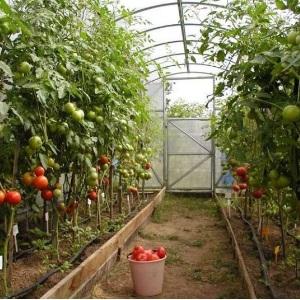 The harvest time depends entirely on the air temperature and humidity in the greenhouse. Also, this period depends on the type of plant.
The harvest time depends entirely on the air temperature and humidity in the greenhouse. Also, this period depends on the type of plant.
The health and maturity of the fruits depends on the right time, which will affect not only the taste characteristics of tomatoes, but also their transportability and shelf life.
When picking tomatoes, follow these rules:
- Fruits should be slightly unripe, with a light brown color and green spots.
- Collect the fruit with the stalk. This will preserve the elasticity of tomatoes, their fullness with vitamins and other useful components.
- Harvest tomatoes until night temperatures drop below 8 ° C.
Some Tips for Proper Tomato Care
The success of growing tomatoes in a polycarbonate greenhouse depends on many factors:
- varieties;
- seed health;
- temperature regime (during the day 25-28 ° С, and at night not lower than 15 ° С);
- soil temperature (not lower than 17-18 ° С);
- humidity of air and soil in the greenhouse (not higher than 65%);
- the correctness of pinching;
When growing tomatoes, you need to remember about some "not allowed":
- you cannot grow plants in oily, overly fertilized soil with organic matter;
- bird droppings and manure should not be placed in the tomato holes, as they will cause the plants to go into greenery, and not into fruits;
- you cannot fertilize tomatoes with a mullein more than three times a season;
- you cannot put urea under the plants, you can spray it only once at the beginning of the growing season;
- you can not plant plants in the shade and too thick;
- do not pour tomatoes with water.
After the second half of July, feeding tomatoes should be stopped.
What is the difference between the process of growing tomatoes in a greenhouse
Growing tomatoes in a polycarbonate greenhouse is significantly different from the same process in open ground.
In a polycarbonate greenhouse, the temperature on hot sunny days can rise above + 50-55 degrees. Therefore, when choosing a greenhouse design, you should consider the ventilation system. It is better that the greenhouse be equipped with a system of vents in the roof.
The humidity in the greenhouse is higher than in the open field. Permissible air humidity - 60%. At higher rates, airing is carried out, otherwise the risk of fungal diseases increases, and the fruits may crack.
Another feature of the greenhouse is the absence of pollinating insects and wind. Although tomatoes are self-pollinating crops, in indoor conditions, the pollen needs to be helped to reach the pistil. To do this, shake the flower brushes slightly.
Conclusion
Growing tomatoes in a polycarbonate greenhouse is quite simple, but you need to know the peculiarities of the growth and development of tomatoes in a greenhouse. Remember that adhering to agricultural standards will ensure good yields and help prevent disease.